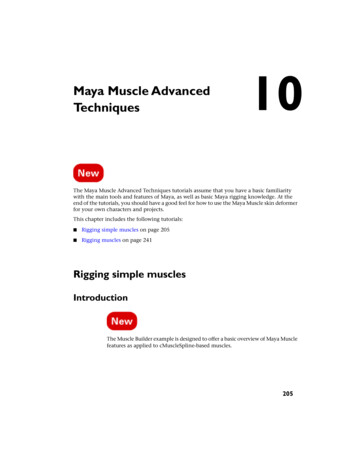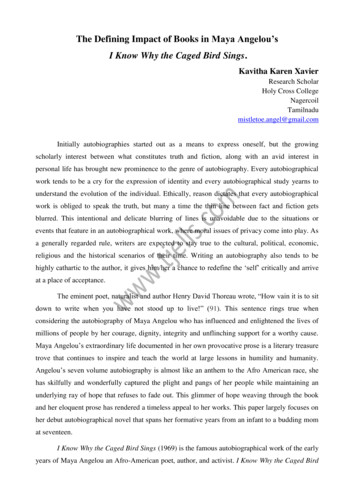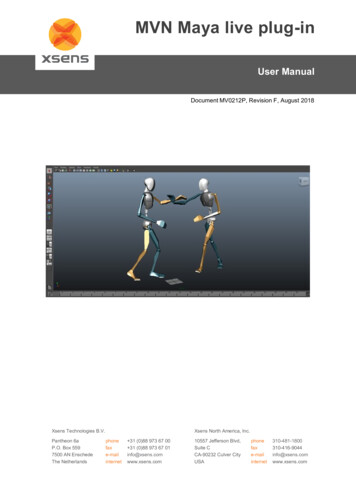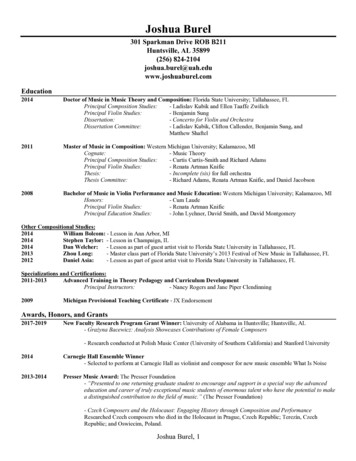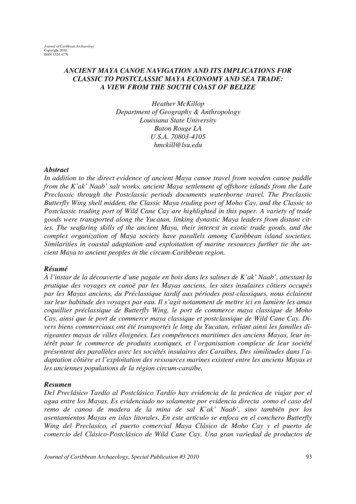
Transcription
NBER WORKING PAPER SERIESCAN SMALLHOLDER EXTENSION TRANSFORM AFRICAN AGRICULTURE?Joshua W. DeutschmannMaya DuruKim SiegalEmilia TjernströmWorking Paper 26054http://www.nber.org/papers/w26054NATIONAL BUREAU OF ECONOMIC RESEARCH1050 Massachusetts AvenueCambridge, MA 02138July 2019, Revised February 2021The authors thank Kibrom Abay, Brad Barham, Chris Barrett, Lori Beaman, Leah Bevis, LorenzoCasaburi, Travis Lybbert, Nick Magnan, Jeremy Magruder, William Masters, Laura Schechter,Andrew Simons, Jeffrey Smith, Tavneet Suri, and Chris Udry for helpful comments andsuggestions. We have also benefitted from comments by seminar and conference participants atCSAE, the IDEAS Summer School in Development, the NBER & African Development BankTransforming Rural Africa Conference, NEUDC, Y-RISE, and the UW-Madison Agriculturaland Applied Economics development workshop. All remaining errors are our own. StrathmoreUniversity’s IRB approved the study (IRB Approval Number: SU/IRB 0062/16). We registeredthe trial with the AEA Social Science Registry (AEARCTR-0006675). Author order randomizedusing the AEA Random Author Order tool (Confirmation code: xA0K-1 Ven8y). The viewsexpressed herein are those of the authors and do not necessarily reflect the views of the NationalBureau of Economic Research.NBER working papers are circulated for discussion and comment purposes. They have not beenpeer-reviewed or been subject to the review by the NBER Board of Directors that accompaniesofficial NBER publications. 2019 by Joshua W. Deutschmann, Maya Duru, Kim Siegal, and Emilia Tjernström. All rightsreserved. Short sections of text, not to exceed two paragraphs, may be quoted without explicitpermission provided that full credit, including notice, is given to the source.
Can Smallholder Extension Transform African Agriculture?Joshua W. Deutschmann, Maya Duru, Kim Siegal, and Emilia TjernströmNBER Working Paper No. 26054July 2019, Revised February 2021JEL No. O12,O13,Q12ABSTRACTAgricultural productivity in Sub-Saharan Africa lags behind all other regions of the world.Decades of investment in agricultural research and extension have yielded more evidence on whatfails than on what works—especially for the small-scale producers who dominate the sector. Westudy a program that targets multiple constraints to productivity at once, similar to anti-poverty“graduation” interventions. Analyzing a randomized controlled trial in western Kenya, we findthat participation causes statistically and economically significant gains in output, yields, andprofits. In our preferred specification, the program increases maize production by 26% and profitsby 16%. The program increases yields uniformly across the sample, while treatment effects ontotal output and profit impacts are slightly attenuated at the top end of the distribution.Joshua W. DeutschmannAgricultural & Applied EconomicsUniversity of Wisconsin-Madison427 Lorch St.Madison, WI 53706jdeutschmann@wisc.eduMaya DuruThe Abdul Latif Jameel Poverty Action Lab400 Main StreetE19-201Cambridge, MA 02142mduru@povertyactionlab.orgKim SiegalOne Acre Fund80 Broad St. Suite 2500New York, NY 10004kim.siegal@oneacrefund.orgEmilia TjernströmSchool of EconomicsUniversity of SydneyA02 - Social Sciences BuildingNSW 2006Australiaemilia.tjernstrom@sydney.edu.au
How should scarce public resources be allocated across sectors of the economy to advancegrowth? This question occupies a central role in development economics and policy debates.As a large contributor to GDP, employment, and food security, the agricultural sectoris often at the heart of such discussions. While agriculture’s role in driving growth istheoretically ambiguous (Matsuyama, 1992), a growing body of empirical evidence linksincreased staple yields to greater national welfare (Bravo-Ortega and Lederman, 2005;Ligon and Sadoulet, 2011; Ravallion and Chen, 2007) and structural change (McArthur andMcCord, 2017). More recently, Gollin, Hansen and Wingender (2018) show that agriculturalproductivity shocks—as measured by the adoption of improved crop varieties—generatelarge per-capita GDP increases.Investments in the agricultural sector in sub-Saharan Africa (SSA) have yielded considerable evidence on what fails and a limited catalog of successes. Despite substantialgovernment and donor expenditures on research and extension programs, agricultural inputsubsidies, and insurance products, agricultural productivity in SSA still lags behind allother regions of the world (Block, 2014; World Bank, 2008). The fact that expenditureshave failed to transform the agricultural sector in SSA serves as a kind of Rorschach testfor researchers and policy-makers alike. To some, widening agricultural productivity gapsindicate that public resources would be better spent elsewhere. To others, the existenceof constraints limiting technology adoption and commercialization suggests that relaxingthose constraints with well-designed and targeted investments could stimulate dramaticincreases in African smallholder agricultural productivity and economic growth (Byerlee,de Janvry and Sadoulet, 2009; Magruder, 2018).Our paper contributes to this policy debate by documenting that a multi-faceted programcan generate economically meaningful returns. Despite the importance of the agriculturalsector, there is a dearth of rigorous empirical evidence on agricultural extension serviceeffectiveness. High-quality evaluations of programs operating at scale are especially rare.Research efforts often suffer from issues of measurement, selection, and comparability acrossprograms (Aker, 2011; Anderson and Feder, 2007). Relatively few experimental studies findpositive impacts on farmer practices or improved input use—and even then, researchersoften fail to detect measurable increases in yields (Udry et al., 2019) or profits (Beamanet al., 2013).We report experimental results from a cluster-randomized RCT of a program thattargets small-scale staple crop producers: the One Acre Fund (1AF) program. 1AF is anon-governmental organization (NGO), established in 2006, that currently works with over2
one million farm households in seven countries across Eastern and Southern Africa. Westudy 1AF’s programming by randomizing access to their scaled-up operations in Kenya.We find that program participation causes statistically and economically significant increasesin output, yields, and profits. In our preferred specification, total maize output increasesby 26% and profits increase by 16%. Our estimated treatment effects are robust acrossempirical specifications.Our paper builds on the literature studying technology diffusion in low-income countries.Within this body of work, three constraints stand out as key barriers to adoption ofimproved agricultural technologies: credit, risk, and information (Feder, Just and Zilberman,1985; Magruder, 2018). The components of 1AF’s programming are closely tied to theseconstraints: participating farmers receive input loans for high-quality seeds and fertilizer,crop insurance, and training on improved farming practices. None of the ingredients of theprogram are based on radical ideas; in fact, they overlap substantially with the kinds ofprograms that the World Bank promoted as part of their agricultural extension investmentsin the 1960s and 1970s (Birkhaeuser, Evenson and Feder, 1991).These similarities aside, the 1AF program distinguishes itself from its antecedents bytightly bundling the component parts into a single unified package (Tinsley and Agapitova,2018). This kind of bundling is not typical of government-led extension, nor is it commonin the economics literature on technology adoption. Since bundled interventions make itdifficult to disentangle the underlying economic mechanisms, the academic literature tendsto evaluate the impact of relaxing a single constraint at a time—this is especially true inthe growing experimental literature reviewed by Magruder (2018).The theoretical literature on poverty traps is a notable exception to the frequent focuson single constraints. A growing empirical body of evidence complements this theoreticalliterature by investigating the possibility that poor households may need large, bundledinterventions in order to move out of poverty (Banerjee et al., 2015; Bandiera et al., 2017;Balboni et al., 2020). Our results echo recent findings from multi-faceted anti-povertyprograms, where individual intervention components seem unable to generate the gainsachieved by the full program.One interpretation of our results is that past research may have underestimated thepotential for well-designed programs to increase agricultural productivity. To the extent thatgovernments and donors make their investment choices based on evidence, these findingscould lead to more efficient decision-making. We discuss some candidate explanations forwhy our findings differ from those in the literature in Section 5. Disentangling among these3
and establishing the external validity of our findings would be fruitful avenues for futureresearch.In light of the recent proliferation of social enterprises offering financial and extensionservices to farmers, we undertake two sets of complementary analyses. First, we examinewhether the average treatment effects mask underlying impact heterogeneity using econometric and machine learning techniques. Treatment effect heterogeneity could indicatepotential efficiency gains from programmatic changes or improved participant targeting.Perhaps surprisingly, treatment effects on maize yields are large and consistent across thesample. The treatment effects on total maize output and profits are lower at the top endof the distribution. The relative lack of heterogeneity may be due to the small upfrontfee that 1AF requires prior to enrollment—another difference between 1AF and its manypredecessors. If the fee screens potential participants and drives positive selection into theprogram, this could explain the homogeneous impacts.1Second, we match our sample to administrative records from the subsequent growingseason to study participant enrollment decisions at the extensive and intensive margins.Being randomly assigned to the program in 2017 does not affect enrollment probabilitiesin 2018. However, farmers who are randomly exposed to the program in 2017 enrollsignificantly more land in the program the following year. These effects are consistent witha successive easing of constraints as well as with participants learning about the returns tothe program through participation.1Context, data, and experimental design1.1One Acre Fund’s program in KenyaWe analyze the main operating model of an established agricultural NGO, One Acre Fund.Founded in 2006, the organization has grown rapidly in the last several years: enrollmenthas grown from 200,000 farm households in 2014 to more than one million in 2020 (One AcreFund, 2020). 1AF’s “market bundle” provides farmer groups with group-liability loans forimproved seeds and fertilizer, regular training on modern agricultural techniques, crop andfuneral insurance, and market facilitation support to help farmers obtain higher prices for1Studies of health products in low-income countries generally find cost-sharing mechanisms to be ineffectivescreening devices (Ashraf, Berry and Shapiro, 2010; Cohen and Dupas, 2010; Tarozzi et al., 2014). Incontrast, Beaman et al. (2020) find evidence of positive selection into an agricultural credit program in Mali.4
their output (Tinsley and Agapitova, 2018). Farmer groups are organized by geographicalareas and comprised of 8-12 farmers.The program’s focus on credit, risk, and information has support in the economicsliterature, which has accumulated substantial evidence that failures in these domains hinderfarmers’ ability or willingness to adopt improved agricultural technologies (Feder, Justand Zilberman, 1985; Magruder, 2018). 1AF’s focus on providing high-quality inputs alsohas empirical support: a growing literature establishes that fertilizer and seeds sold in theregion’s local markets often fall short of quality standards (Bold et al., 2017; Tjernström,Carter and Lybbert, 2018).Prior to enrolling, participants sort into self-selected farmer groups. The credit component begins with each participant choosing how much of their land to enroll; 1AF determinesthe size of agricultural input loans as a function of the amount of land enrolled. Farmergroups are jointly responsible for repayment of these loans. Loan terms are relativelyflexible, allowing repayment at any time during the growing season. Groups must completerepayment in full within a two-week grace period after harvest.2 To alleviate informationconstraints, 1AF field officers conduct repeated trainings and provide handouts on thebenefits and proper use of improved inputs. To alleviate risk, 1AF provides yield-indexinsurance based on crop cuts and forgives a portion of the input loan in case of cropfailure(Tinsley and Agapitova, 2018).This experiment was conducted in western Kenya, where 1AF has operated for morethan ten years. Agriculture contributes 51% to Kenya’s GDP and is dominated by smallscale producers (Government of Kenya, 2010). Despite the importance of the agriculturalsector to the economy, most small-scale farmers are not running successful micro-enterprises.Households in Kenya typically derive their income from the production of a variety of crops(Sheahan, Black and Jayne, 2013) and average productivity often fails to meet households’dietary needs (Kirimi et al., 2011).Although small-scale farmers in Kenya produce a range of crops across a diverseproduction environment, 1AF’s efforts are focused on the dominant staple crop: maize.Maize is important both to the economy and for food security. Seventy percent of Kenya’smaize is produced by smallholders who farm between 0.2 and 3 hectares (Government ofKenya, 2010, pg. 11-12). While Kenyan farmers use improved seed varieties and inorganicfertilizer at higher rates than neighboring countries, yields remain low. Further, the country2Historically, repayment rates exceed 97% (Tinsley and Agapitova, 2018).5
remains a net importer of maize, despite policy targets to the contrary.1.2Experimental designRecruitment, enrollment, and program implementation for this experiment took place in theTeso region of Kenya, following 1AF’s standard protocol. Farmers who satisfied the basicprogram criteria paid a participation deposit of approximately 5 USD.3 Once participantshad self-selected into groups of 8-12 farmers, the randomization was conducted at the levelof clusters, which consisted of 2-4 of these joint-liability farmer groups. This aggregationwas designed to minimize potential spillovers by maximizing the distance between clusters.After participants had paid the fee and signed the contract, they were informed of therandomization, which took place as a public lottery. The control group farmers, who wererandomly assigned to delay program access received a compensation package consisting ofa bundle of household goods valued at the cost of participation. The control group alsoreceived a discount for enrollment the following season.Dealing with control group contaminationWhile the ideal location for this study would arguably be an area where 1AF had neveroperated, this proved difficult in Kenya. Given 1AF’s long presence in the country, all“untouched” regions would have been unrepresentative of the production environments andfarmer populations that 1AF usually engages with. As a second-best option, the evaluationteam decided to sample villages within an area where 1AF was already working but wherea large population had not yet been offered the program.In practice, although 1AF had never offered its program to the sampled villages, somefarmers had managed to access it anyway, by “commuting” to neighboring villages toparticipate. The proportion of such “pre-exposed” farmers does not differ across treatmentand control. We may nonetheless be concerned that the pre-exposed farmers introduce biasinto our results. Accordingly, we report our main results both for the full sample and forthe “primary sample,” which refers to the sample of farmers who had never participated in1AF programming.3The participation criteria for the standard program is possession of a phone number and nationalidentification. Study participants had to consent to be part of the study and plan to cultivate at least 0.25acres of maize. After contract signing, 1AF informed farmers about the study, that their participation wouldbe voluntary, and went over informed consent.6
The sign of any potential bias depends on at least two factors: the persistence oftreatment effects and the correlation between selection and program returns. Suppose that1AF participation changes farmers’ production processes for the better. If pre-exposedfarmers continue to operate more efficiently in subsequent seasons, then treatment effectsestimated using the full sample may be attenuated.We also do not know the sign of the correlation between self-selection into early accessand returns to enrollment. If the most eager farmers have higher returns, we would expectthe impacts on our primary sample of hold-out farmers to be a lower bound of the trueimpacts. If these hold-out farmers instead resemble the never-adopters in Suri (2011) andhave surprisingly high returns—but perhaps face high costs of participation—then it ispossible that focusing solely on the primary sample might overestimate impacts.1.3DataThe data collection was managed by the NGO. The evaluation team took several steps toreduce concerns about research independence: First, the International Initiative for ImpactEvaluation (3ie) helped design and review all parts of the trial (the experimental design,field protocols, sampling, randomization, and data collection instruments (Dubey andYegbemey, 2017)). Second, the data collection included back-checks and in-field supervision.Third, 1AF contracted an independent firm, Intermedia Development Consultants, to carryout a three-step audit of the data collection. Appendix A documents 3ie’s review of thepre-analysis plan, and Appendix G provides more details about the audit procedures andresults.Fourth, the main dependent variables, yield and land size, were physically weighed andmeasured with GPS, respectively, which should minimize the potential for social desirabilitybias.4 All weighing and surveying was carried out by 1AF enumerator staff from outside thestudy area who did not know the sample farmers. Finally, two of the authors on this paperwere brought in as independent evaluators. This part of the team reviewed the pre-analysisplan (PAP) prior to data collection and independently conducted the data cleaning, variableconstruction, and analysis.Baseline data collection took place in November and December of 2016—after initialenrollment but before contract signing. A public lottery assigned clusters of farmer groups4Social desirability bias can be a concern if participants or enumerators change answers in an attempt tohelp.7
to treatment in January 2017. Enumerator teams conducted input use surveys after theplanting of the main season in 2017, from April through June. Enumerators collected freshweight measurements between July-August 2017 and dry weight measurements betweenJuly-September 2017.Outcome variablesFollowing our PAP, our main analysis centers on program maize yields, total maize output,and profits. Program yields capture a direct comparison of average yield on treated farmers’enrolled land to the average yield in the control group. Since farmers rarely enroll all oftheir land, we might worry about various forms of spillovers across a given farmer’s plots.5Total output should better capture the overall welfare effects for participants—net of anycross-field substitution.To obtain “crop cut” yields, enumerators collected and physically weighed fresh anddry harvests from two randomly placed 40-square-meter boxes. Cultivated land sizes weremeasured by GPS readings, with enumerators walking the boundaries of each plot threetimes.6 Based on the objective measures of land size and crop cut yields, we generate morestandard per-acre yield and total output measures.Enumerators collected separate crop cut measurements for enrolled land and non-enrolledland in the treatment group. While program maize yields refers to treated farmers’ per-acreyield on their enrolled plot, total maize output is a weighted average of per-acre yieldson the enrolled vs. non-enrolled plot (with weights proportional to the amount of land ineach category). Control farmers did not separate their fields into enrolled and non-enrolledsub-plots. For them, program yields equal per-acre yields on a randomly-selected maizeplot. Total output is scaled up to their total land under maize cultivation.7Finally, we calculate profits as the value of output less farmers’ costs. Revenues arethe product of total output and average market prices from nearby vendors. For controlfarmers, input costs are elicited via self-reports. For treatment farmers, we know the input5For example, there could be positive knowledge spillovers to non-enrolled plots, or participants mayreallocate scarce complementary inputs such as labor to the enrolled plot. Conversely, farmers might preferto spread 1AF-provided inputs across multiple plots in an effort to reduce risk.6A growing body of research documents non-classical measurement error in self-reported land size andharvests in developing-country studies (see e.g. Abay, Bevis and Barrett 2019; Carletto, Savastano andZezza 2013; Desiere and Jolliffe 2018; Gourlay, Kilic and Lobell 2017). Self-reported harvests are additionallysubject to recall bias.7Appendix C provides additional variable construction details.8
costs on the enrolled land (since these are administered by the program); we elicit otherinput costs with self-reports.8Labor costs are challenging to measure in this context, given the prevalence of unpaidlabor. To reduce recall bias, we elicit early-season paid and family labor use in a surveyadministered shortly after planting (including labor for land preparation, plowing, andplanting). Late-season family and paid labor use, including for weeding and harvest, wascollected shortly after harvest. We ascribe a monetary value to unpaid labor by calculatingthe mean day wage reported within the sample and devaluing this mean wage by 50%(based on rural unemployment rates in Kenyan DHS data). We then multiply this devaluedmean by the number of person-days of unpaid labor.9AttritionAttrition in our data is mostly due to missing variables, not to participants dropping out ofthe sample entirely. During data cleaning, we are forced to drop observations for missingland size and harvest data. Land size data was collected during and immediately afterharvest time and enumerators struggled to measure all plots of all farmers. Harvest datawas recorded both immediately after harvest (the “fresh weight”) and after drying (the “dryweight”). Our analysis relies on dry weight estimates of yields, which are a more comparablemeasure across farmers since moisture content before drying can vary. For some droppedobservations, dry weight data is missing but not fresh weight. For others, we are missingboth.In Appendix E, we include a more complete description of the attrition and implementseveral imputation strategies to test the robustness of our results. Section 2 shows that ourresults are consistent across various robustness checks, including missing-data imputationmethods.Sample description and balance testsWe report summary statistics and balance tests on our pre-specified control variables inAppendix B. In addition to balance checks for treatment and control groups, we comparebaseline characteristics of our two sub-populations: the “primary” sample (farmers who8Overall, the data confirm that 1AF charges prices for seeds and fertilizer that are comparable to localmarket prices.9See Appendix E for a discussion of alternative valuations of unpaid labor.9
have never enrolled in 1AF) and the “pre-exposed,” who had previously enrolled in 1AFprogramming. The two groups together make up the “full sample.”Summary statistics in Table 4 confirm the importance of agriculture for this population:nearly eighty percent of participants earned more than half of their income from farmlabor in the year prior to the study. On average, participants cultivated roughly one acreof maize, harvesting about half a ton per acre. While three-quarters of the sample usedimproved agricultural technologies at baseline, average input intensity is low. About halfof the respondents report some knowledge of 1AF planting practices, which is primarilydriven by the pre-exposed farmers.10Although household size, education, and baseline maize yields differ significantly acrosstreatment and control, an F -test of joint orthogonality of the variables in Table 4 does notreject the null that all the variables are jointly orthogonal to treatment status. None of thethree significantly different variables are highly correlated with our outcome variables, sothe differences are unlikely to affect our results. It may seem counter-intuitive that baselinemaize yields do not correlate with maize yields, but these variables are very noisy and lowautocorrelation is common.We also compare participants in the primary sample to those who enrolled prior tothe study (Table 7). At baseline, farmers who self-selected into early program accessare more educated, cultivate more maize land, report using improved inputs and havingaccess to credit, and are more likely to have prior knowledge of 1AF practices. We cannotdetermine whether this is due to early enrollees being better off to start or whether programparticipation contributed to the observed differences.2ResultsWe obtain intent-to-treat estimates of program impacts by estimating the following regressionwith OLS:yics α βTcs δXics γs εics(1)where yics denotes the outcome for individual i in cluster c and strata s, with strata definedbased on 1AF field-office areas. The indicator variable Tcs takes on a value of one forclusters assigned to treatment. Xics is a vector of pre-specified controls, γs is a strata fixedeffect to account for variations in the probability of assignment to treatment, and εics is10Appendix B provides more detail, including separate balance tables for primary and pre-exposed samples.10
clustered at the level of treatment assignment (farmer group clusters).Our PAP specified Xics in Eq. 1 as including controls for household demographics(marital status, household size, education, credit access, land ownership, agriculturalreliance) and baseline agricultural characteristics (technology use, intercropping, knowledgeof 1AF practices).11Otherwise, we follow the PAP closely and present results with andwithout controls, which does not affect our results. The standard errors in our main resultsare not adjusted for multiple hypothesis testing.122.1Intermediate outcomes: behavioral changeBefore turning to our main outcome variables, we examine intermediate outcomes thatcapture participant behavior. We would expect treatment effects to be traceable throughobservable changes in farmer behavior. Concretely, 1AF trains farmers on practical detailssuch as the correct spacing between rows of plants and plants within a row, as well as thetiming of different fertilizer applications.13Treatment effects on production decisionsWe examine several extensive- and intensive-margin aspects of production. Panel A of 1reports treatment effects on the extensive margin of key practices, estimated with linearprobability models.14 The outcome variables in columns (1) and (2) are dummies forwhether participants planted within 5 cm of 1AF’s recommended spacing (between rowsand for plants within rows, respectively). In column (3), fertilizer timing equals one if theparticipant applied fertilizer at the appropriate time of the season. High maize productivityrequires substantial amounts of nitrogen—but the timing matters. Maize plants requirerelatively little nutrient input at the time of planting and are most responsive to inputslater in the season. Accordingly, farmers are recommended to apply DAP (diammonium11Where appropriate, regressions also include a control for past exposure to the 1AF program. Additionally,the PAP proposed to include a spillover inverse probability weight, with spillover likelihood measured by afarmer’s total agricultural contacts that were randomized into treatment. Including this weighting does notchange the statistical significance or qualitative interpretation of our results (see Table 19); for parsimonywe report un-weighted results.12See Table 18 for MHT-adjusted and randomization inference p-values, none of which change theinterpretation of our results.13Each practice is tied to farming aspects that 1AF has identified as important for crop yields; theseare documented in a 95-page manual. Appropriate plant density avoids plants competing for sunlight andnutrients while maximizing the use of scarce land by not planting too sparsely.14See Table 11 in Appendix D for analogous results when we restrict to the primary sample.11
phosphate) at planting and CAN (calcium ammonium nitrate) several weeks later. As aplacebo test we include an indicator variable for participant use of an ox-driven plow. 1AFemphasizes the timing of plowing over the method. Since most farmers do not own anox-plow, 1AF discourages waiting for one to become available and encourage focusing ontiming relative to the rainy season onset.Columns (1)-(3) show that treated participants are more likely than control farmers tofollow spacing recommendations. Adherence to recommended spacing increases by almost60% (160%) for row spacing (plant spacing) among farmers unacquainted with the program.Similarly, treated farmers are 170% more likely to use
Maya Duru The Abdul Latif Jameel Poverty Action Lab 400 Main Street E19-201 Cambridge, MA 02142 mduru@povertyactionlab.org Kim Siegal One Acre Fund 80 Broad St. Suite 2500 New York, NY 10004 kim.siegal@oneacrefund.org . (Banerjeeetal.,2015;Bandieraetal.,2017; Balboni et al., 2020). Our results echo recent findings from multi-faceted anti-poverty
